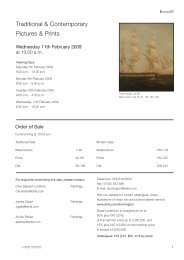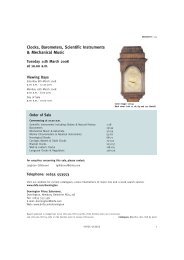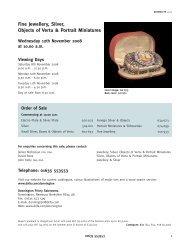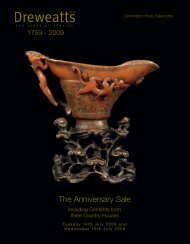Donnington Priory Salerooms
Donnington Priory Salerooms
Donnington Priory Salerooms
You also want an ePaper? Increase the reach of your titles
YUMPU automatically turns print PDFs into web optimized ePapers that Google loves.
52<br />
A Victorian engraved gilt-brass<br />
carriage timepiece<br />
Dent, London, mid 19th century<br />
The four-pillar single fusee movement<br />
with Harrison’s maintaining power, lever<br />
escapement between the plates, and<br />
vertical monometallic balance with foliate<br />
engraved backcock and regulation<br />
pointer mounted on the backplate<br />
inscribed Dent, London, 1739, PATENT<br />
LEVER, the rectangular foliate-scroll<br />
engraved single-sheet silvered dial with<br />
Roman numeral chapter ring and gilt<br />
hands, the case with shaped hinged<br />
handle, concave caddy and spire finials<br />
above recessed frieze, bevel glazed doors<br />
to front and rear and deep foliate scroll<br />
work to sides divided by turned pilasters<br />
to angles, on stepped moulded base with<br />
turned feet, 11.5cm high excluding<br />
handle.<br />
According to Mercer (Mercer, Vaudrey<br />
EDWARD JOHN DENT AND HIS<br />
SUCCESSORS page 178) carriage<br />
clocks signed Dent, London can be<br />
included within the series signed<br />
E.J. Dent.... hence the current lot would<br />
have probably been made shortly prior to<br />
Edward John Dent’s death in 1853.<br />
Edward John Dent was a talented<br />
horologist who at the age of 17<br />
transferred his apprenticeship from the<br />
trade of tallow chandler to watchmaking<br />
under the charge of Edward Gaudin in<br />
1807. By 1814 he was becoming well<br />
known as a watch and clockmaker<br />
receiving commissions from the Admiralty<br />
for a ‘Standard Astronomical Clock’ and<br />
pocket chronometers for the Colonial<br />
Office Africa Expedition. In 1830 Dent<br />
went into partnership with the renowned<br />
watch and chronometer maker John<br />
Roger Arnold which continued until 1840<br />
when he left and set up business alone<br />
as E.J. Dent at 82 Strand, London,<br />
primarily making marine chronometers,<br />
watches and precision clocks. In 1852<br />
Edward Dent successfully tendered to<br />
make the Great Clock to be housed in St.<br />
Stephens Tower at the New Palace of<br />
Westminster. The clock was completed in<br />
1859, apparently at a financial loss to the<br />
firm, however it ensured that the Dent<br />
name became a household name<br />
synonymous with fine clockmaking. After<br />
his death in 1853 the firm was continued<br />
by his successors and was still trading<br />
well into the latter half of the 20th century.<br />
£1,500-2,000<br />
01635 553553<br />
23






